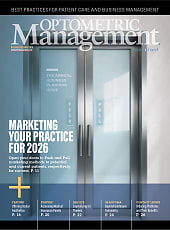Dry Eye Dx and Tx
A New Algorithm for Diagnosing Severe Dry Eye
BY KATHERINE M. MASTROTA, MS, OD, FAAO

Clinicians engaged in dry eye diagnosis and management are often frustrated by the inconsistent and incongruous signs and symptoms of dry eye disease. The Odissey European Consensus Group, comprised of international dry eye experts, convened to establish a consensus-based, simplified, two-step algorithm for diagnosing severe dry eye disease, even in the event of discordance between signs and symptoms (Baudouin et al, 2014).
The Odissey algorithm differs from the Delphi panel (Behrens et al, 2006) and Dry Eye WorkShop (DEWS) graded schemata (DEWS Report, 2007) that rank dry eye disease severity by simultaneous exacerbation of signs and symptoms and that require both severe signs and significant symptoms before the disease is considered “severe.”
The New Algorithm
The first step of the Odissey algorithm evaluates the minimum number of fundamental criteria required for severe dry eye disease diagnosis. Interestingly, the panel suggested that just two criteria, a symptomatic assessment (via Ocular Surface Disease Index [OSDI], score ≥33) and an evaluation of ocular surface damage by corneal fluorescein staining (CFS, Oxford Scheme ≥3), would be sufficient to adequately evaluate dry eye severity for the majority of patients. Any patient who meets these two primary criteria is diagnosed as having severe dry eye.
If there is discordance between the primary criteria—that is, when OSDI and CFS severity scoring are not in agreement—then additional dry eye markers are considered. The eight determinant criteria for dry eye disease severity that Odissey includes are:
• Conjunctival staining (graded as severe)
• Schirmer’s test (<3mm)
• Impaired visual function (positive)
• Filamentary keratitis (positive)
• Tear hyperosmolarity (>328mOsm/L)
• Impression cytology ≥ Grade 3 Nelson Scale
• Blepharospasm (positive)
• Meibomian gland disease (strong positive)
The presence of just one of the above clinical criteria in addition to an OSDI score ≥33 or CFS ≥3 is accepted as a diagnosis of severe dry eye disease in the Odissey paradigm.
Future Impact
Although the Odissey method for establishing severe dry eye disease may seem simplistic, it is an important, patient-tailored attempt to facilitate the assessment of ocular surface damage and the characterization of disease severity. To date, dry eye lacks a reliable tool to identify severe disease because methods are poorly standardized, non-correlation between severity and clinical disease markers is common, and the nature of individual variability in symptomatology and disease signs may be confounding.
The Odissey group hopes that, once validated, this new algorithm may be useful in clinical trials as it can better define trial outcomes, accelerating the clinical development of new dry eye treatments. The full article text is available at http://bjo.bmj.com/content/early/2014/03/13/bjophthalmol-2013-304619.long. CLS
For references, please visit www.clspectrum.com/references and click on document #223.
Dr. Mastrota is secretary of the Anterior Segment Section of the American Academy of Optometry. She is a consultant or advisor to Allergan, B+L, BioTissue, Nicox, and OcuSoft and is a stock shareholder of TearLab Corporation. Contact her at katherinemastrota@msn.com.



